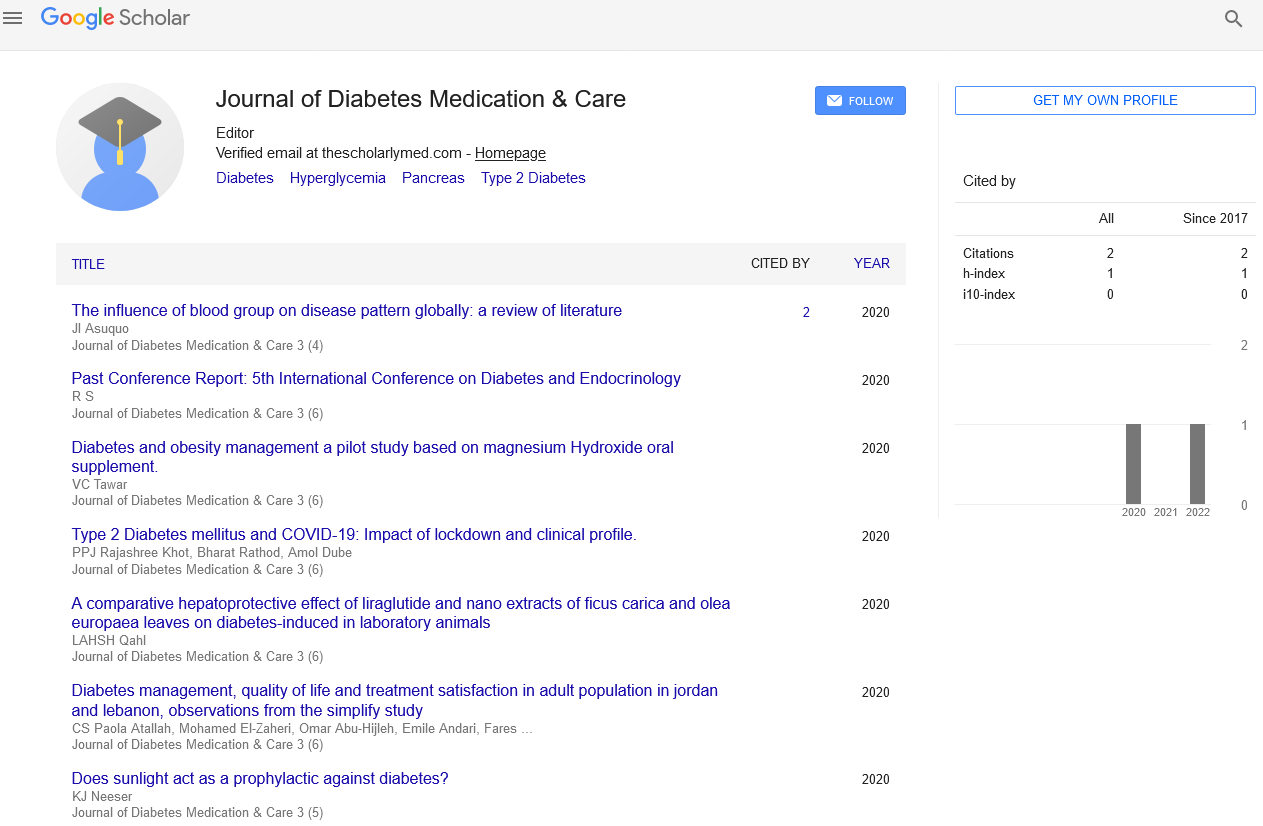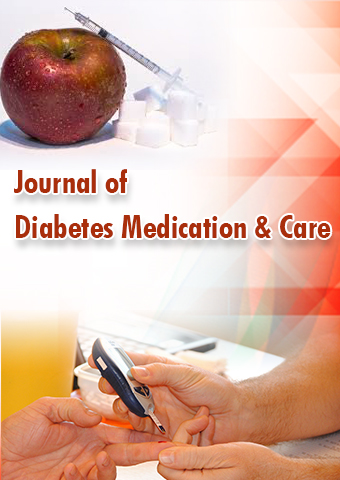Mini Review - Journal of Diabetes Medication & Care (2022) Volume 5, Issue 5
A Study to Evaluate Any Relationship between Glycosylated Haemoglobin
Dr. Numar Debiat*
Head of Department, consultant endocrinologist, city hospital, healthcare, Dubai, United Arab Emirates
Head of Department, consultant endocrinologist, city hospital, healthcare, Dubai, United Arab Emirates
E-mail: debiatnumar@debiat.com
Received: 28-Sep-2022, Manuscript No. JDMC-22-76371; Editor assigned: 01-Oct-2022, PreQC No. JDMC-22-76371; Reviewed: 10-Oct-2022, QC No. JDMC-22-76371; Revised: 17-Oct-2022, Manuscript No JDMC-22-76371 (R); Published: 28-Oct-2022 DOI: 10.37532/jdmc.2022.5(5).88-90
Abstract
This retrospective chart review will evaluate if there are any correlations between elevated HbA1c, using the 7% ruling (recommended by the American Diabetes Association) and peripheral neuropathy found during diabetic foot assessments. Diabetes is a global endemic with rapidly increasing prevalence in both developing and developed countries. The American Diabetes Association has recommended gyrated haemoglobin (HbA1c) as a possible substitute to fasting blood glucose for diagnosis of diabetes. HbA1c is an important indicator of long-term glycaemic control with the ability to reflect the cumulative glycaemic history of the preceding two to three months. HbA1c not only provides a reliable measure of chronic hyperglycaemia but also correlates well with the risk of long-term diabetes complications. Elevated HbA1c has also been regarded as an independent risk factor for coronary heart disease and stroke in subjects with or without diabetes. The valuable information provided by a single HbA1c test has rendered it as a reliable biomarker for the diagnosis and prognosis of diabetes. This review highlights the role of HbA1c in diagnosis and prognosis of diabetes patients.
Introduction
Analysis of glycated haemoglobin (HbA1c) in blood provides evidence about an individual’s average blood glucose levels during the previous two to three months, which is the predicted half-life of red blood cells (RBCs) [1]. The HbA1c is now recommended as a standard of care (SOC) for testing and monitoring diabetes, specifically the type 2diabetes [2]. Historically, HbA1c was first isolated by Huisman et al. In 1958 and characterized by Book chin and Gallop4 in 1968, as a glycoprotein. The elevated levels of HbA1c in diabetic patients were reported in 1969. Identified the pathway leading to the formation of HbA1c in 1975. Using the HbA1c as a biomarker for monitoring the levels of glucose among diabetic patients was first proposed in 1976 [3].
The increasing prevalence of diabetes is a major cause of concern worldwide [4]. As a consequence, the associated complications of diabetes are on the rise. Previous large studies have shown that elevated glycosylated haemoglobin (HbA1c) is a major risk factor in the occurrence and progression of diabetic complications. One of the most feared of these complications is diabetic foot complications. Peripheral neuropathy is the leading cause of foot ulceration and resultant lower limb amputation. Due to the lack of treatment that targets the principal nerve damage, it is imperative to assess early risk factors in order to prevent and manage this pathology [5].
Method
227 diabetic foot assessments were performed on 20 Type 1 and 207 Type 2 diabetics from a specified diabetes centre over a 4 months period using a 10g monofilament, neurotips, 128Hz tuning fork and at times, a sudoscan. The latest HbA1c within the last 12 months was collated and used in this study [6]. Out of 227 subjects, 2 diabetic foot assessments were inconclusive. 67 out of 225 (29.8%) subjects had clinical peripheral neuropathy and/or exhibiting symptoms of neuropathy. Subsequently, 8 of the neuropathic subjects were excluded due to lack of HbA1c data. Furthermore, 37 of the 59 (62.7%) neuropathic patients had an HbA1c above 7%. There is also evidence that glycosylation of haemoglobin impairs nitric oxide (NO)-related relaxation of human mesenteric vessels [7]. Haemoglobin glycosylation is also reported to alter NO binding with this resulting in lowered NO bioavailability and impaired vasodilatation in rabbit aortic rings. Another mechanism by which glycosylation of haemoglobin is proposed to be vasoactive is via the formation of reactive oxygen species.88 Glycosylation of haemoglobin also lowers oxygen-carrying capacity, thereby promoting hypoxia and its related systemic vascular vasodilatory adaptations and responses [8]. Conclusion The results demonstrate a relationship between elevated HbA1c and peripheral neuropathy. Consequently, health practitioners should focus on preventative measures by attempting to reduce and maintain HbA1c levels below 7% in order to reduce the likelihood of nerve damage occurring leading to peripheral neuropathy. In 2017, the global prevalence of diabetes was 425 million people worldwide, or 8% of adults between 20-79 years (1). Additionally, it is set to rise to 629 million people by 2045. In part, the emergence of the diabetes pandemic is attributable to established causes, primarily the increasing number of older people and growing levels of obesity and physical inactivity. As a consequence of the increasing prevalence, the complications associated with diabetes are expected to increase. Therefore, it is imperative to take preventative measures to reduce the common risks associated with diabetes. The principle diabetic complications affect the eyes, kidneys and the nervous system leading to pathologies such as retinopathy, nephropathy and peripheral neuropathy. In addition, type 2 diabetes can affect the macrovascular system increasing the risk of strokes and cardiovascular disease. Type 2 diabetes is the leading cause of blindness, renal failure and lower limb amputations. These complications are a result of the micro vascular effects of the disease. A pre-requisite of lower limb amputation is diabetic foot ulceration. Diabetic foot ulceration is a serious problem for patients. The early detection of risk factors is a pivotal part of preventing the complications occurring in the first place. Risk factors for foot ulceration in diabetes include male gender, poor glycaemic control, and long duration of diabetes, PAD, foot deformity, a history of prior ulcers or amputation and peripheral neuropathy. There are various types of diabetic peripheral neuropathy. The most Researched are distal symmetric polyneuropathy (DSPN), diabetic autonomic neuropathy and cardiovascular autonomic neuropathy (CAN). A patient may suffer from one or a combination of these neuropathies. In this study, we will focus on DSPN as it commonly affects the nerves of the lower limbs leading to peripheral neuropathy. DSPN is a chronic and insidious complication of Diabetes. DSPN has a lifetime prevalence of approximately 50% of diabetics and is the leading cause of disability due to foot ulceration and amputation, gait disturbances, and fall related injury. DSPN has been classified by Toronto Consensus Panel on Diabetic Neuropathy as a “symmetrical length-dependant sensorimotor polyneuropathy attributable to metabolic and micro vessel alterations as a result of chronic hyperglycaemia exposure and cardiovascular risk covarities”. Sensory symptoms such as numbness, tingling, pins and needles and burning sensations start distally in the toes and over time affect both the upper and lower limb in a distribution called the “Glove and Stocking Effect”. It is important to note that more than half of DSPN sufferers are asymptomatic therefore examinations should be carried out regardless of the presence or absence of a patient complaint. Currently, there is lack of treatment that targets the principal nerve damage therefore, early detection and preventative actions are crucial in the care of diabetic patients. Currently, there are studies released that aimed to find if there are any correlations between intensively controlled HbA1c below 7% (recommended by the American Diabetes Association) and the development of micro vascular complications such as neuropathy. The UK Prospective Study (UKPDS) gathered data from 3867 newly diagnosed Type 2 diabetics. They were randomly assigned into an intensive or conventional control group. The intensive glycaemic control group had a median haemoglobin A1C (HbA1c) of 7% compared to the conventional group’s 7.9%. After 10 years follow up, the effect of intensive glycaemic control on macrovascular complications was statistically insignificant. However, they found that the intensive group showed an overall 25% risk reduction in micro vascular diabetic complications such as peripheral neuropathy. The prospective randomized study: Diabetes Control and Complications Trial (DCCT) analysed 1441 subjects over 6.5 years. They found, definitively that there is a reduced risk of micro vascular complications such as nephropathy, retinopathy and neuropathy. Furthermore, they found that intense glycaemic control delayed the onset and slowed the progression of neuropathy. Khalid et al (2009) published a study of 50 asymptomatic diabetics over a 4 year period. In this study, 25 patients were organized in the well- controlled glycaemic group and had an HBA1c of< 7% whilst the other 25 patients were placed in the uncontrolled group and had an HbA1c of> 7%. They established that HbA1c was the most important factor in predicting neuropathy, more so than the duration of diabetes. Overall, their findings proved that poorly controlled diabetes is 11 times more likely to have neuropathy in comparison to well-controlled diabetes. Additionally, they found that the nervous changes take place before the clinical symptoms are observed. Therefore, the progression of neuropathy and neuropathic symptoms are related to chronic hyperglycaemia. As a result, early preventative measures will yield better results for neuropathy. On the other hand, the researchers discussed the main limitation of this study which is the small sample size. Consequently, the results of this study can be imparted as questionable. Meta-analysis of randomized trials of 28,614 participants. They found that there was an insignificant effect on the macrovascular and micro vascular complications with intensive glycaemic control compared to standard glycaemic control. However, in this study, they did not look into DSPN solely but focused on micro vascular complications of retinopathy and nephropathy. Lastly, there results were widely based on “lack of sufficient evidence” to support any outcome rather than factual, statistical evidence to prove either conclusion.
Acknowledgement
None
Conflict of Interest
None
References
- Currie Craig J, Peters John R, Tynan Aodán et al. Survival as a function of HbA1c in people with type 2 diabetes: a retrospective cohort study. The Lancet. 375, 481-489 (2010).
- Heller, Simon R. A Summary of the Advance Trial. Diabetes Care. 32, 357-361 (2009).
- Gerstein HC, Miller ME, Byington RP et al. Effects of Intensive Glucose Lowering in Type 2 Diabetes. NEJM. 358, 2545-2559.
- Nathan DM, Kuenen J, Borg R et al. Translating the A1C assay into estimated average glucose values. Diabetes Care. 31, 1473-1478.
- Sun J, Buys NJ. Glucose- and glycaemic factor-lowering effects of probiotics on diabetes: a meta-analysis of randomised placebo-controlled trials. British Journal of Nutrition. 115, 1167-1177 (2016).
- Bunn HF, Higgins PJ. Reaction of monosaccharides with proteins: possible evolutionary significance. Science. 213. 222-224 (1981).
- Miedema K. Standardization of HbA1c and Optimal Range of Monitoring. Scand J Clin La Investig 240, 61-72 (2005).
- Warman DJ, Jia H, Kato H et al. The Potential Roles of Probiotics, Resistant Starch, and Resistant Proteins in Ameliorating Inflammation during Aging (Inflammaging). Nutrients. 14, 747 (2022).
Indexed at, Google Scholar, Crossref
Indexed at, Google Scholar, Crossref
Indexed at, Google Scholar, Crossref
Indexed at, Google Scholar, Crossref
Indexed at, Google Scholar, Crossref
Indexed at, Google Scholar, Crossref
Indexed at, Google Scholar, Crossref

